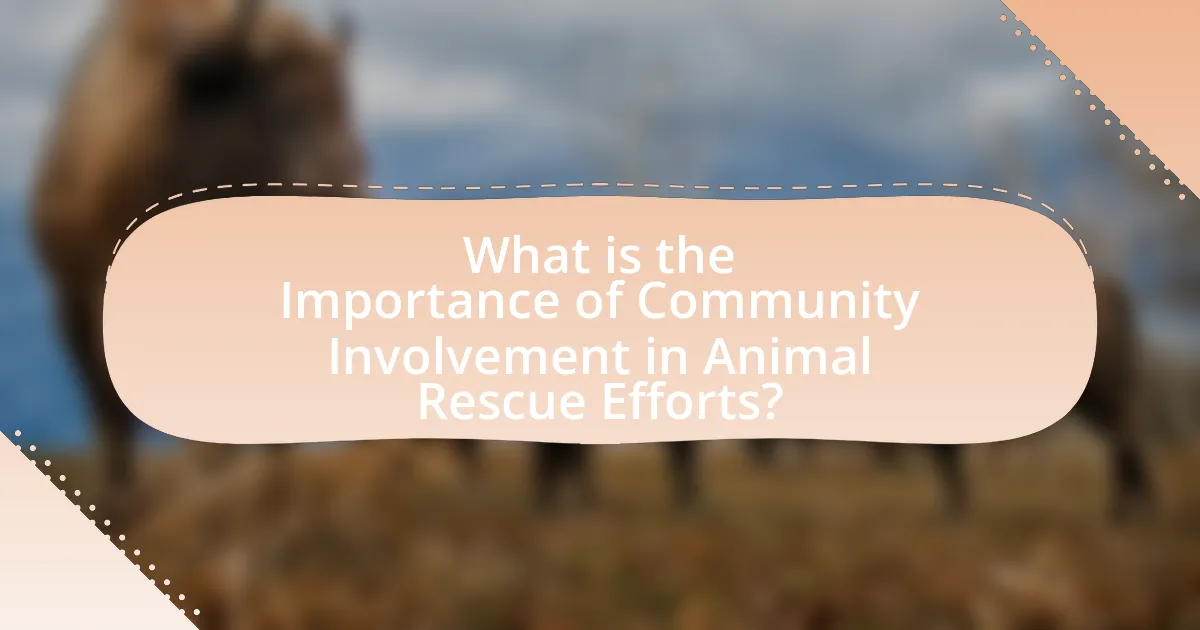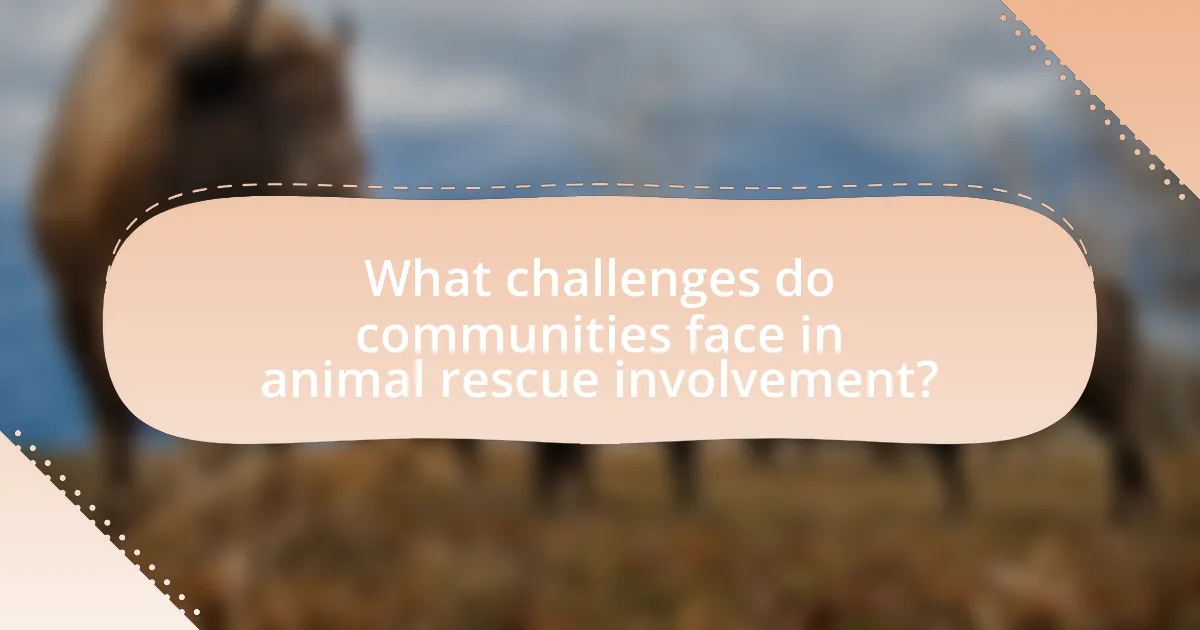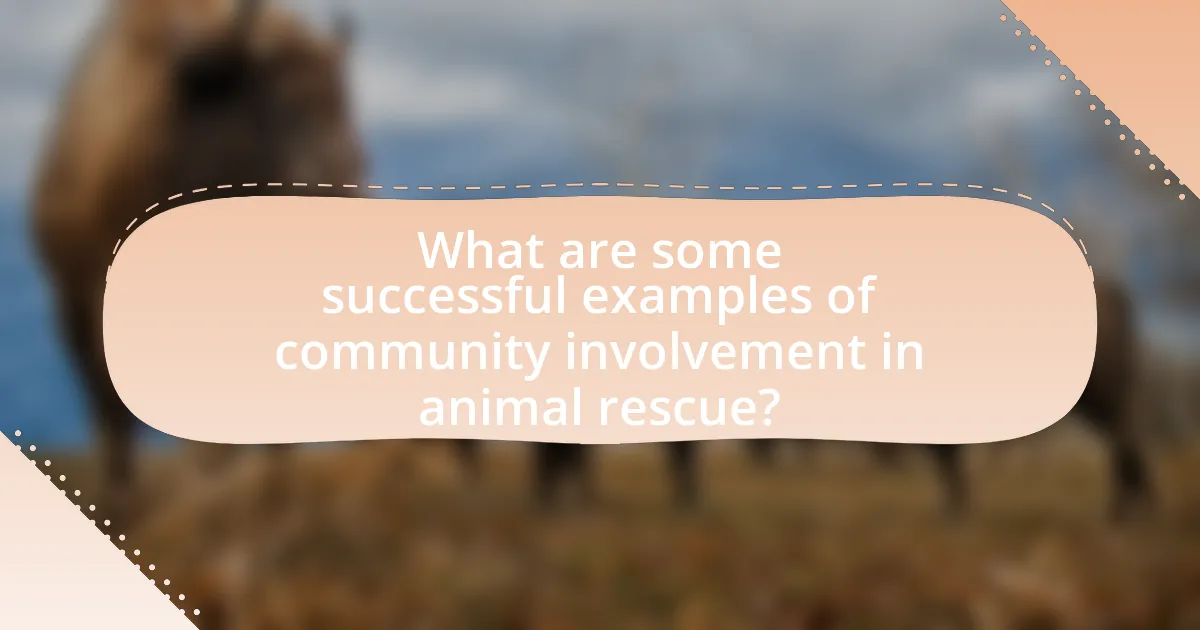The main entity of the article is community involvement in animal rescue efforts. The article emphasizes the critical role that local engagement plays in enhancing resource availability, increasing public awareness, and fostering a supportive network for animal welfare. It discusses how active community participation leads to higher rates of donations, volunteer support, and successful adoptions, ultimately improving animal welfare outcomes. Key benefits of community involvement include increased resources, enhanced awareness, and improved rescue operations, while also addressing challenges such as limited resources and misconceptions. The article outlines practical steps individuals and communities can take to effectively engage in animal rescue initiatives.

What is the Importance of Community Involvement in Animal Rescue Efforts?
Community involvement is crucial in animal rescue efforts as it enhances resource availability, increases public awareness, and fosters a supportive network for animal welfare. Engaging local residents can lead to increased donations, volunteer support, and the sharing of information about animals in need, which directly contributes to higher rescue rates. For instance, a study by the ASPCA indicates that communities with active volunteer programs see a 30% increase in successful adoptions compared to those without such involvement. This demonstrates that when communities unite for animal rescue, they create a more effective and sustainable approach to addressing the needs of vulnerable animals.
Why is community involvement crucial for animal rescue organizations?
Community involvement is crucial for animal rescue organizations because it enhances resource availability and fosters a supportive network for animal welfare. Engaging the community leads to increased donations, volunteer support, and awareness of animal issues, which are vital for the sustainability of rescue operations. For instance, a study by the ASPCA indicates that organizations with strong community ties report a 30% increase in volunteer participation and a 25% rise in financial contributions. This involvement not only helps in rescuing more animals but also promotes responsible pet ownership and reduces the number of animals in shelters.
How does community support enhance the effectiveness of rescue operations?
Community support enhances the effectiveness of rescue operations by providing essential resources, manpower, and local knowledge. When communities actively participate, they can mobilize volunteers quickly, which increases the number of hands available for rescue efforts. For instance, during natural disasters, local volunteers often know the terrain and can navigate it more effectively than external responders, leading to faster rescues. Additionally, community members can contribute supplies such as food, shelter, and medical assistance, which are critical for the well-being of rescued animals. Studies have shown that community involvement can significantly reduce response times and improve overall outcomes in rescue operations, demonstrating the vital role that local support plays in these efforts.
What role does public awareness play in animal rescue efforts?
Public awareness is crucial in animal rescue efforts as it drives community engagement and support for initiatives aimed at protecting and rehabilitating animals. Increased awareness leads to higher rates of adoption, volunteer participation, and donations, which are essential for the sustainability of rescue organizations. For instance, a study by the ASPCA found that communities with higher public awareness campaigns saw a 30% increase in adoption rates over a year. This demonstrates that informed communities are more likely to take action, ultimately enhancing the effectiveness of animal rescue operations.
What are the key benefits of community involvement in animal rescue?
Community involvement in animal rescue provides essential benefits such as increased resources, enhanced awareness, and improved animal welfare. Engaging the community leads to more volunteers, donations, and foster homes, which are critical for the operational success of rescue organizations. For instance, a study by the ASPCA indicates that communities with active volunteer programs see a 30% increase in successful adoptions. Furthermore, community participation raises awareness about animal welfare issues, encouraging responsible pet ownership and reducing the number of animals in need. This collective effort ultimately results in better care and rehabilitation for rescued animals, demonstrating the significant impact of community involvement in animal rescue initiatives.
How does community participation improve animal welfare outcomes?
Community participation improves animal welfare outcomes by fostering collaboration between local stakeholders and animal welfare organizations. Engaging community members in rescue efforts leads to increased awareness of animal needs, resulting in more effective interventions. For instance, studies have shown that communities involved in animal welfare initiatives report higher rates of adoption and lower instances of neglect, as local residents become more informed and proactive in caring for animals. Additionally, community-driven programs often mobilize resources and volunteers, enhancing the capacity of animal shelters and rescue groups to provide care and support.
What impact does community involvement have on funding and resources?
Community involvement significantly enhances funding and resources for animal rescue efforts. Engaged communities often contribute through donations, volunteer work, and fundraising events, which directly increase the financial and material support available to rescue organizations. For instance, a study by the National Council of Nonprofits found that organizations with strong community ties receive 50% more in donations compared to those without such connections. This financial boost allows animal rescue groups to expand their services, improve facilities, and provide better care for animals in need.
How can communities effectively engage in animal rescue efforts?
Communities can effectively engage in animal rescue efforts by organizing local initiatives such as adoption events, fundraising drives, and volunteer programs. These initiatives mobilize community members to contribute resources, time, and skills towards rescuing and caring for animals in need. For instance, a study by the ASPCA indicates that community-based programs significantly increase adoption rates and foster a culture of compassion towards animals. Additionally, collaboration with local shelters and veterinary services enhances the effectiveness of these efforts, ensuring that rescued animals receive necessary medical care and support.
What types of volunteer opportunities are available in animal rescue?
Volunteer opportunities in animal rescue include fostering animals, assisting with adoption events, providing administrative support, participating in fundraising activities, and engaging in community outreach programs. Fostering allows volunteers to care for animals in their homes until they find permanent placements, which is crucial for reducing shelter overcrowding. Assisting with adoption events helps connect animals with potential adopters, increasing their chances of finding forever homes. Administrative support is vital for the smooth operation of rescue organizations, including tasks like data entry and managing social media. Fundraising activities are essential for generating the financial resources needed to care for rescued animals. Lastly, community outreach programs educate the public about responsible pet ownership and the importance of spaying and neutering, which can lead to a decrease in the number of animals in need of rescue.
How can local businesses contribute to animal rescue initiatives?
Local businesses can contribute to animal rescue initiatives by providing financial support, resources, and volunteer efforts. For instance, businesses can sponsor local animal shelters or rescue organizations through donations or fundraising events, which directly aids in covering operational costs and medical care for animals. Additionally, they can offer in-kind donations such as food, supplies, or services, which are essential for the daily functioning of rescue operations. Furthermore, employees can volunteer their time to assist in rescue activities, fostering a culture of community involvement. According to the ASPCA, community partnerships significantly enhance the effectiveness of animal rescue efforts, demonstrating that local businesses play a crucial role in supporting these initiatives.

What challenges do communities face in animal rescue involvement?
Communities face several challenges in animal rescue involvement, including limited resources, lack of awareness, and insufficient volunteer engagement. Limited resources, such as funding and facilities, hinder the ability to provide adequate care for rescued animals. A survey by the ASPCA indicates that 65% of animal shelters operate on budgets of less than $500,000, which restricts their capacity to rescue and rehabilitate animals effectively. Lack of awareness about the importance of animal rescue can lead to low community participation, as many individuals may not understand the impact of their involvement. Additionally, insufficient volunteer engagement can result from time constraints and competing priorities, making it difficult for organizations to mobilize enough support for rescue efforts. These challenges collectively impede the effectiveness of community involvement in animal rescue initiatives.
What barriers prevent community members from participating in animal rescue?
Barriers that prevent community members from participating in animal rescue include lack of awareness, financial constraints, and time limitations. Many individuals are unaware of local animal rescue initiatives or the specific needs of animals in their area, which hinders their involvement. Financial constraints can deter potential volunteers from contributing, as they may feel unable to cover costs associated with rescue efforts, such as transportation or supplies. Additionally, time limitations due to work or personal commitments often prevent community members from dedicating time to rescue activities. These factors collectively reduce community engagement in animal rescue efforts.
How can misconceptions about animal rescue be addressed?
Misconceptions about animal rescue can be addressed through education and community engagement. By providing accurate information about the realities of animal rescue, such as the challenges faced by shelters and the importance of spaying and neutering pets, communities can foster a better understanding. Research indicates that educational programs and outreach initiatives significantly improve public perceptions and increase support for rescue efforts. For instance, a study by the ASPCA found that communities with active educational campaigns saw a 30% increase in adoption rates, demonstrating the effectiveness of informed community involvement in dispelling myths surrounding animal rescue.
What logistical issues hinder community engagement in rescue efforts?
Logistical issues that hinder community engagement in rescue efforts include inadequate transportation, lack of resources, and insufficient communication. Inadequate transportation limits the ability of volunteers to reach affected areas quickly, which delays rescue operations. Lack of resources, such as funding and supplies, restricts the capacity of organizations to mobilize effectively and support community involvement. Insufficient communication between rescue organizations and the community can lead to misunderstandings about needs and available opportunities for engagement, ultimately reducing volunteer participation. These factors collectively impede the effectiveness of community-driven rescue efforts.
How can communities overcome these challenges?
Communities can overcome challenges in animal rescue efforts by fostering collaboration among local organizations, volunteers, and government agencies. This collaboration can lead to resource sharing, increased awareness, and more effective outreach programs. For instance, a study by the ASPCA indicates that communities with strong partnerships between shelters and local businesses see a 30% increase in adoption rates. Additionally, implementing educational programs about responsible pet ownership can reduce the number of abandoned animals, as evidenced by successful initiatives in cities like San Diego, where community workshops have led to a significant decline in stray populations.
What strategies can be implemented to increase community participation?
To increase community participation in animal rescue efforts, organizations can implement strategies such as hosting educational workshops, creating volunteer programs, and utilizing social media campaigns. Educational workshops inform the community about animal welfare issues, fostering a sense of responsibility and engagement. For instance, a study by the American Society for the Prevention of Cruelty to Animals (ASPCA) found that communities with regular educational outreach saw a 30% increase in volunteer involvement. Volunteer programs provide hands-on opportunities for community members to contribute, which can enhance their commitment to the cause. Additionally, social media campaigns can effectively reach a broader audience, encouraging participation through shares and interactions; research indicates that social media engagement can increase event attendance by up to 50%. These strategies collectively enhance community involvement in animal rescue efforts.
How can partnerships with local organizations enhance community involvement?
Partnerships with local organizations enhance community involvement by creating collaborative platforms that mobilize resources and expertise for animal rescue efforts. These partnerships facilitate joint initiatives, such as community awareness campaigns and fundraising events, which engage residents and foster a sense of shared responsibility. For instance, a study by the National Council of Nonprofits indicates that organizations collaborating with local entities can increase volunteer participation by up to 50%, demonstrating the effectiveness of collective action in driving community engagement.

What are some successful examples of community involvement in animal rescue?
Successful examples of community involvement in animal rescue include local fundraising events, volunteer programs, and partnerships with businesses. For instance, the “Bark in the Park” event organized by the Humane Society of the United States raised over $1 million for animal shelters through community participation. Additionally, volunteer programs like “Foster a Pet” have successfully mobilized community members to provide temporary homes for animals, significantly increasing adoption rates. Furthermore, collaborations with local businesses, such as pet supply stores hosting adoption days, have proven effective in connecting animals with potential adopters, enhancing community engagement in animal welfare.
What case studies illustrate effective community engagement in animal rescue?
Case studies illustrating effective community engagement in animal rescue include the “Pawtucket Animal Shelter Community Outreach Program” and the “San Francisco Animal Care and Control Volunteer Program.” The Pawtucket program successfully increased adoption rates by 40% over two years through community events and partnerships with local businesses, demonstrating the impact of collaborative efforts. Similarly, the San Francisco program engaged over 1,000 volunteers annually, resulting in a 30% reduction in shelter population and enhanced community awareness about animal welfare. These examples highlight how structured community involvement can lead to significant improvements in animal rescue outcomes.
How did specific communities mobilize for successful rescue operations?
Specific communities mobilized for successful rescue operations by organizing local volunteer groups, leveraging social media for awareness, and collaborating with animal welfare organizations. For instance, during natural disasters, communities often form task forces that include trained volunteers who can provide immediate assistance. Social media platforms serve as effective tools for disseminating information about missing animals and coordinating rescue efforts, as seen in the aftermath of Hurricane Katrina, where community-led initiatives played a crucial role in rescuing displaced pets. Additionally, partnerships with established animal welfare organizations enhance resource availability and expertise, leading to more effective rescue operations.
What lessons can be learned from these successful examples?
Successful examples of community involvement in animal rescue efforts demonstrate the importance of collaboration, resource sharing, and local engagement. These cases show that when communities unite, they can effectively mobilize volunteers, raise funds, and increase awareness about animal welfare issues. For instance, organizations like the ASPCA have reported that community-driven initiatives lead to higher adoption rates and reduced euthanasia numbers, highlighting the effectiveness of local participation in rescue efforts. Additionally, successful programs often incorporate educational outreach, which fosters a culture of compassion and responsibility towards animals, further enhancing community support for rescue initiatives.
What best practices can communities adopt for effective animal rescue involvement?
Communities can adopt several best practices for effective animal rescue involvement, including establishing local rescue networks, organizing volunteer training programs, and promoting public awareness campaigns. Local rescue networks facilitate collaboration among individuals, shelters, and organizations, enhancing resource sharing and response efficiency. Volunteer training programs equip community members with essential skills, such as animal handling and first aid, which are critical during rescue operations. Public awareness campaigns educate residents about responsible pet ownership and the importance of spaying and neutering, ultimately reducing the number of abandoned animals. These practices have been shown to improve rescue outcomes and foster a culture of compassion towards animals within the community.
How can communities create sustainable volunteer programs?
Communities can create sustainable volunteer programs by establishing clear goals, providing training, and fostering strong partnerships with local organizations. Clear goals ensure that volunteers understand their roles and the impact of their contributions, which enhances motivation and retention. Training equips volunteers with the necessary skills and knowledge, making them more effective in their tasks. Strong partnerships with local organizations, such as animal shelters and rescue groups, can provide resources and support, ensuring that volunteer efforts align with community needs. Research indicates that programs with structured training and community collaboration have higher volunteer satisfaction and retention rates, leading to more effective and sustainable initiatives.
What role does education play in fostering community involvement in animal rescue?
Education plays a crucial role in fostering community involvement in animal rescue by raising awareness about animal welfare issues and encouraging responsible pet ownership. Through educational programs, individuals learn about the importance of spaying and neutering pets, the impact of overpopulation, and the benefits of adopting animals from shelters. Research indicates that communities with strong educational initiatives see higher rates of volunteerism and donations to animal rescue organizations, as informed citizens are more likely to engage in supportive actions. For instance, a study by the American Society for the Prevention of Cruelty to Animals (ASPCA) found that communities with educational outreach programs experienced a 30% increase in adoption rates and a significant rise in community volunteer participation. This demonstrates that education not only informs but also empowers individuals to take action in support of animal rescue efforts.
What practical steps can individuals take to support animal rescue efforts in their community?
Individuals can support animal rescue efforts in their community by volunteering at local shelters, fostering animals, and donating supplies or funds. Volunteering provides essential manpower for daily operations, while fostering helps alleviate overcrowding in shelters. Donations of food, toys, and medical supplies directly benefit the animals in need. According to the ASPCA, community involvement significantly enhances the effectiveness of rescue organizations, leading to higher adoption rates and improved animal welfare.